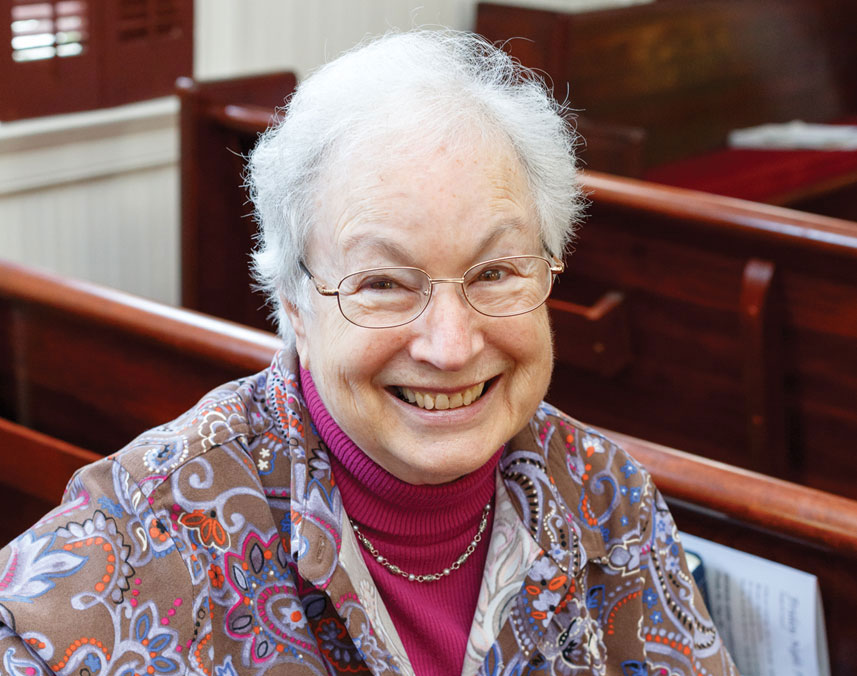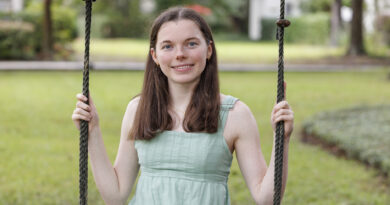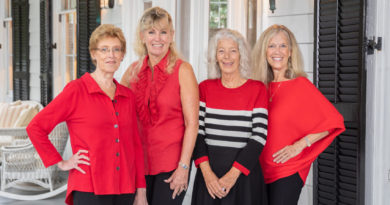Chanukah: The Festival of Lights
 As the sunlight sparkles off the river waters of Beaufort, adding to the beauty of the lowcountry, so do the luminous tones of diversity add sparkle to its community life. One bright ray is Beaufort’s Jewish community, which has been a significant part of the history of Beaufort since before the 17th century , and continues to flourish today through Beth Israel Synagogue, where Jewish families have been gathering since 1908.
As the sunlight sparkles off the river waters of Beaufort, adding to the beauty of the lowcountry, so do the luminous tones of diversity add sparkle to its community life. One bright ray is Beaufort’s Jewish community, which has been a significant part of the history of Beaufort since before the 17th century , and continues to flourish today through Beth Israel Synagogue, where Jewish families have been gathering since 1908.
Ritual Director of Beth Israel congregation, Regina Carmel says, “People have the view that being Jewish in the south is difficult but they could not be more wrong. Here in Beaufort the Jews are, and always have been, an integral part of the community. We are respected within the community, and we are involved in all Houses of Worship activities. The Jewish community has thrived here.”
Beth Israel History
Beth Israel Synagogue (the name means House of Israel) was chartered and incorporated in 1905 and completed, much of it by congregants, in 1908.The graceful and charming historic building embodies within its structure the unique history of Beaufort. It was designed by an African American architect, unusual for that era; the windows were repurposed from an African American church that was being torn down at the time. Look through the original wavy glass and you will basically see the same view of historic downtown Beaufort the original congregants would have seen in 1908. A cupboard that holds the prayer books is made from packing crates from the original Lipsitz Department Store; look inside and you can still see the name Lipsitz stenciled on the wood. The building is filled with irreplaceable heirlooms that are cherished by the congregation.
Regina Carmel says, “Many of the Synagogue founders came here from Lithuania in the late nineteenth century, as part of the mass immigration of that era, fleeing European persecution. Most were merchants who lived above their shops on Bay Street. Beth Israel was specifically situated nearby so they could walk to Sabbath and holy day services, a requirement for the then Orthodox congregation.” (The synagogue became a Conservative congregation in 1949).“In 1910 the congregation bought a tract of land on Bladen Street, for a cemetery that is still in use today, “ says Regina Carmel.” The Synagogue hosts school field trips and is part of a number of Historic Houses of Worship tours. It also hosts many Jewish visitors to Beaufort. Last January, it became part of the National Historic Register.
History of Chanukah
Chanukah , or Hanukkah, is not in the Bible, but is found in the Book of Maccabees, in the Apocrypha, or Septuagint, a group of writings from the time of the Greeks, after the Bible canon had been completed. It is called the Festival of Lights and occurs on the 25th of Kislev, the 9th month of the Jewish calendar, at the darkest time of the year. While Christmas is fixed on December 25th each year, Chanukah’s dates differ. The holidays often overlap but they otherwise differ in purpose and origin.
Chanukah celebrates two miracles, one of which is history, the other of which is legend. The first miracle is the second century victory of a small, greatly outnumbered army of Jews, known as the Maccabees, over their Assyrian conquerors, descendants of Alexander the Great. The seven-year war was for the right of the Jews to practice their religion, culture, and traditions in their homeland. The conquerors’ attempts to eradicate Judaism by force had failed.
The second of the miracles occurred after the Jewish military victory and is known as the Miracle of the Oil. Regina Carmel says, “ When the Maccabees liberated the Temple Mount in Jerusalem, their first desire was to relight the Temple menorah, the eternal light, and to place it so that all around the hills and valleys of Jerusalem, the Jews would see it and know the Maccabean Revolt had been won and along with it, their freedom. However, the Temple had been desecrated by the Assyrians and only one day’s holy oil could be found. The Temple was hurriedly reconsecrated and miraculously, enough holy oil was found to keep the menorah burning for eight days. The reconsecration of the Temple was called Chanukat HaBayit; Dedication of the House.”
Chanukah Traditions
This year Chanukah will be from December 16th through December 24th and is it is celebrated by lighting the menorah, or Chanukiah, enjoying traditional foods, playing dreidel games and exchanging small gifts.
Menorahs can be fashioned in any shape or form, as long as there are places for nine candles (eight for every day of Chanukah and one to hold the candle that lights the others.) In Beth Israel’s Social Hall, there is a charming display of all kinds of menorahs, from antiques to one that includes the Statue of Liberty. On each of the eight days of Chanukah, a candle is lit at nightfall , continuing every night so that by the eighth night, the entire chanukiah/menorah is ablaze with candle light.
A dreidel is a four sided top customarily used to play games throughout the holiday. On each of the four sides is a Hebrew letter; together they form the acronym of the phrase Nes gadol hayah sham, which translates to “A great miracle happened there.” Israeli children change the wording of the dreidel to: A Great Miracle Happened HERE. Depending on what letter shows atop the dreidel when it stops, loot is won or lost. In Roman times, the game was used as a ruse to enable Jews to gather and study, a crime punishable by death. Roman soldiers would be heard coming down the street in their armor. Religious study materials were hurriedly hidden and, upon entry, the soldier would find a group of Jews innocently gambling over a dreidel game. In such ways, Torah, or Jewish laws, customs, and history were committed to memory and passed on from generation to generation.
Traditional foods of Chanukah reflect the miracle of the oil, and are different for the various regions of origin of Diaspora Jews. Those whose heritage is Eastern European, or Ashkenazim, enjoy latkes, potato pancakes fried in oil. Mediterranean Jews, or Sephardim, who can be from France, Italy, Greece, and Israel among other countries, eat jelly donuts, also fried in oil. Foods with cheese are also served as a nod to the Apocryphal Book of Judith, in which the Jewish heroine beheads the Assyrian Governor General of Judea, Holofernes. According to the story, she enticed him with cheese, making him very thirsty. Then, she gave him many glasses of wine to quench that thirst, lulling the general to sleep. At that point, she decapitated him, thereby saving her people.
Gifts
“In America, because we all live together, side by side, the gift giving comes from the Christmas holiday. But traditionally the gifts were small”, says Regina Carmel. “My mom, now 96 and a refugee of Hitler’s Germany, used to tell us that in her childhood home, it was customary to give the eleven children peanuts and other small goodies for Chanukah. Chanukah is not the ‘Jewish Christmas’. Although both holidays come at the same time of year, Chanukah celebrates freedom, the victory of the few over the many, and the right to worship as Jews.”
Beth Israel Tradition
A hall was added on to the Beth Israel Sanctuary in 1956 to accommodate social functions. Lined with photos, it is a relaxed and welcoming room that continues to serve as gathering spot, including an annual Chanukah party.
Regina Carmel says, “First, we bless the holiday by lighting colorful candles on the individual menorahs each of us brings. By the light of those candles, we are led by our cantorial soloist, BenZion Bronshtein and his guitar in singing Chanukah songs. Then, we enjoy a buffet of traditional potato latkes, baked by our men’s group, as well as a feast of other specialties prepared by members. We share our annual Chanukah program with local members of an international Jewish women’s group, Hadassah, whose members come from the entire Low Country area. This is one holiday on the Jewish calendar which is pure celebration and we look forward to it from year to year.”
Regina Carmel
Regina Carmel was born in Brooklyn, New York and grew up in a traditional Jewish household. Her parents were German Holocaust survivors, immigrants who became proud American citizens. She says, “My parents loved the United States, and were very grateful to the country that saved their lives.” At the age of 17, Regina went to Israel with a group of youngsters for a year to live and work on a kibbutz. The group hiked the entire country, which laid the groundwork for a lifelong affiliation to Israel. Later, her daughter, Jordana, repeated that experience. Regina says, “Israel is a very important part of my life, and I am still very close to friends I made there in that year.” After fifty plus years teaching Jewish Studies in the Washington, DC metro area, she relocated to Beaufort five years ago and soon became active in the Jewish community and Beth Israel Synagogue.
She says, “In homage to those slain in the Holocaust, in honor of my family, I have lived my life as a Jewish Studies educator, passing our heritage on to coming generations. That is my revenge against those who would destroy us.” Having recently celebrated her mother’s 96th birthday, it is fair to say she comes from a line of strong and determined Jewish women.
Open Door
Beth Israel Synagogue welcomes all visitors. BenZion Bronshtein leads musical Sabbath Services in Hebrew and English every Friday night at 7 PM, Saturday mornings, at 10 AM. Holiday services are as announced.
Beth Israel Synagogue
www.bethisrael-beaufort.com
bethisraelbeaufort@gmail.com
401 Scott Street,
Beaufort, SC. 29902
843-524-4076
Story by CINDY REID
Photography by SUSAN DELOACH




